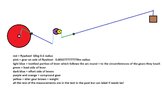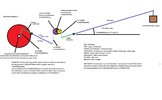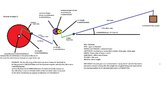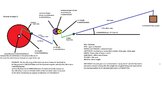I've edited the description of the workings of the device so hopefully easier to read and understand
I want my flywheel whose inertia is 10.8kgm^2 and initial velocity is 3.3873422rad/sec, (after the 18th drop) it has a gear on the axle of it whose radius is 0.0002777777778m. And a lever, whose load side is 0.005m and effort side 0.3m (this is to the right of the wheel) and the arc length on the load side is 0.001745329252m, and because it moves through the angle, and 0.3490658504rad * the length of the load side lever (0.005 ) and 0.001745329252m is also the circumference of the gear on the axle of the flywheel and that's radius is 0.0002777777778m! the effort side moves up which in turn moves the wheel clockwise. an arbitrary angular acceleration is chosen as to be 0.05rad/sec^2. torque equation states that the inertia * angular acceleration equals torque 10.8 * 0.05 = 0.54Nm. torque/radius of gear equals is tangential force 0.54/0.0002777777778m = 1944N. then 1944 * length of load side of the lever = torque, so 1944 * 0.005 = 9.72Nm. then to find the force needed on the end of the lever (over to the right more) 9.72/0.3 = 32.4N moving upwards, find length of arc on effort side of lever one, s = r theta 0.3 * 0.3490658504 = 0.1047197551m, then we make that distance the circumference of the driver gear on a compound gear the bigger one is the driver and the smaller one is the driven so 0.1047197551m/2pi equals the radius of the larger gear on the compound which is 0.01666666667m. make the driven gear 5 times smaller and multiply the force by 5, so 32.4 * 5 = 162N and the radius of the smaller gear is 0.01666666667/5 = 0.003333333334m, then for continuity multiply 162 * 0.003333333334 = 0.54Nm. add an idler gear between the smaller gear on the compound and the toothed portion of the arc of the load side on lever two to make the flywheel turn clockwise. The size of the idler gear is unimportant because it's an idler gear. Make the circumference of the driven gear the distance the load side arc length 0.003333333334 * 2pi = 0.02094395103m. s = r theta, s / theta = r , 0.02094395103/0.3490658504 = 0.06m. 0.06 is the length of the load side of the 2nd lever multiply by 60 because that was the ratio of the first lever and that equals 3.6m for the 2nd lever effort side. Next find the distance of that the end of the effort side is lifted! s = r theta, 3.6 * 0.340658504 = 1.256637061m. then divide 162/60 = 2.7N so the weight of the block that pulls down on the end of the second lever 2.7/9.80665 = 0.2753233775kg then we have torque match up with 2.7N * 3.6m = 9.72Nm, then for energy; F * d 2.7 * 1.256637061 = 3.392920065Joules torque time theta 9.72 * 0.3490658504 = 3.392920066J mgh 0.2753233775 * 9.80665 * 1.256637061 = 3.392920065J to work out the equation for E = 1/2 I * w^2 we must find the angular velocity w2^2 = w1^2 + 2 alpha * theta (w1 is 3.293291461 (after the 18th drop) ) = 3.293291461^2 + 2 * 0.05 * 2pi rad = 11.47408718 take the root and it gives 3.3873422rad/s so plug into energy equation E = 1/2 * 10.8 * 3.3873422^2 which equals 61.96007077J analyse and summarize
I want to edit the gearing so that it takes 15 seconds for the weight to drop on the 19th time round whilst maintaining angular acceleration of 0.05rad/sec^2
and I would like a equation to calculate the linear velocity of the block right before the block hits the floor aswell
I've just realised that all the time I said to the left I meant to the right sorry to confuse!!! now it corrosponds to the diagram again apologies thinking of doubling the larger gear on the compound to 10:1 rather than 5:1 and see what changes (angular acceleration of the flywheel wise)




